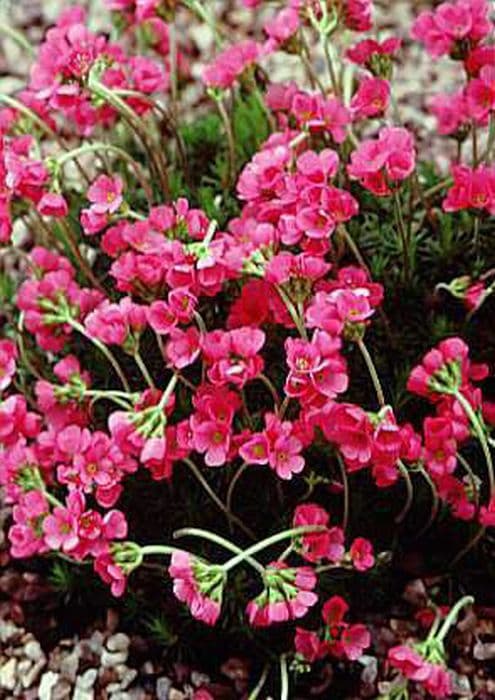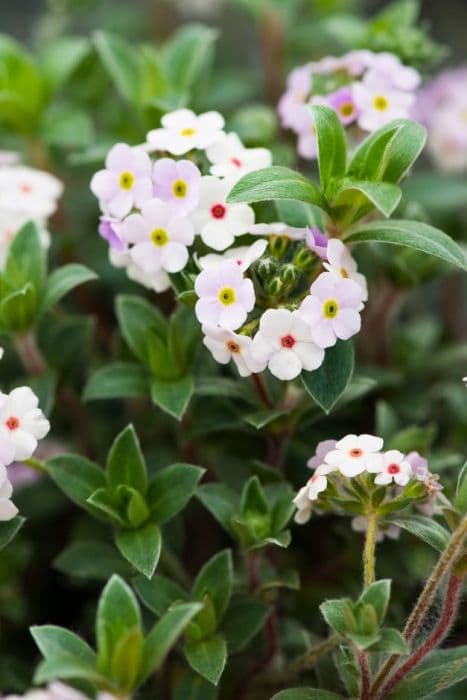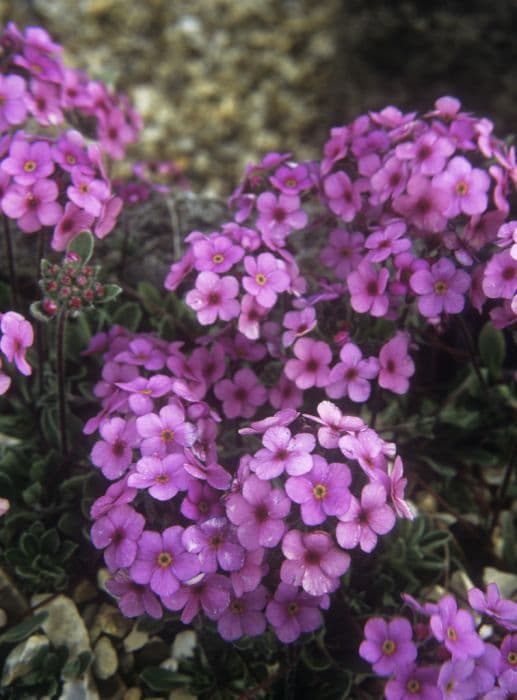Greek Primrose Primula vulgaris subsp. sibthorpii (Pr/prim)

ABOUT
Commonly known as the common primrose, this plant boasts a rosette of tongue-shaped, lush green leaves with somewhat wrinkled edges, giving the foliage a textured appearance. The leaves appear basal, meaning they grow from the base of the plant. The flowers, which are the highlight of this plant, emerge on singular, thin stalks and display a striking color. Each flower consists of five petals that fuse at the base into a tube-like structure. These blossoms usually boast a bright yellow center, also known as the eye, which adds a beautiful contrast to the petals' color. The common primrose blooms in a harmonious cluster, often creating a charming and colorful display that's a herald of spring.
About this plant
 Names
NamesSynonyms
Sibthorp's Primrose, Balkan Primrose, Greek Primrose
Common names
Primula sibthorpii, Primula acaulis subsp. sibthorpii, Primula vulgaris var. sibthorpiifolia
 Toxicity
ToxicityTo humans
Primrose (Pr/prim) is not commonly known for being toxic to humans. However, some people may experience mild irritation or an allergic reaction if they handle the plant and have sensitive skin. Ingesting the plant is not normally associated with serious toxicity, but it can potentially cause stomach upset if consumed in large quantities. It's important to be cautious and avoid ingesting parts of ornamental plants regardless of their toxicity levels.
To pets
Primrose (Pr/prim) may cause mild gastrointestinal upset in pets if ingested. Symptoms of poisoning in pets can include vomiting and diarrhea. Typically, primroses are not known for being severely toxic to pets, but it is still advisable to prevent pets from consuming the plant to avoid any potential discomfort or adverse reactions.
 Characteristics
CharacteristicsLife cycle
Perennials
Foliage type
Evergreen
Color of leaves
Green
Flower color
Pink
Height
6 inches (15 cm)
Spread
6 inches (15 cm)
Plant type
Herb
Hardiness zones
5
Native area
Southeastern Europe
Benefits
 General Benefits
General Benefits- Aesthetic Appeal: Pr/prim adds visual interest to gardens with its vibrant flowers and lush foliage.
- Habitat Support: It provides nectar for early pollinators such as bees and butterflies, facilitating biodiversity.
- Easy to Grow: Pr/prim is known for its hardiness and can thrive in a variety of conditions with minimal care.
- Ground Cover: Its low-growing habit helps suppress weeds, reducing garden maintenance.
- Seasonal Interest: Pr/prim blooms in early spring, filling the seasonal gap when few other plants are flowering.
- Erosion Control: The roots help stabilize soil in sloped gardens, preventing erosion.
 Medical Properties
Medical Properties- This plant is not used for medical purposes.
 Air-purifying Qualities
Air-purifying QualitiesThis plant is not specifically known for air purifying qualities.
 Other Uses
Other Uses- Primula vulgaris subsp. sibthorpii, commonly known as the common primrose, can be used as a natural dye source for textiles, providing a range of yellow and green hues when used with different mordants.
- The flowers of the common primrose can be crystallized and used as edible decorations for cakes and desserts.
- In certain cultures, the leaves of the common primrose can be used as a filler in potpourris to add bulk and a subtle fragrance.
- During the Victorian era, common primrose was often included in "tussie-mussies," small bouquets of flowers with symbolic meanings, to represent young love.
- The flowers of the common primrose can be infused in water to create a fragrant floral water for use in homemade cosmetics or room sprays.
- Young leaves of the common primrose can be a foraged food and add a mild, slightly bitter flavor to salads and sandwiches.
- Primula vulgaris subsp. sibthorpii is used in companion planting as it can attract beneficial insects that help with pest control in gardens.
- The common primrose can be used as a living mulch in garden beds, helping to retain soil moisture and prevent weed growth.
- Leaves of the common primrose may serve as indicators of soil health due to their sensitivity to certain soil conditions, and can be observed by gardeners for signs of soil imbalances.
- In folklore, the common primrose is said to be able to open paths to hidden fairy worlds, and it was traditionally planted near homes to attract good luck and fairy blessings.
Interesting Facts
 Feng Shui
Feng ShuiThe plant Primrose is not used in Feng Shui practice.
 Zodiac Sign Compitability
Zodiac Sign CompitabilityThe plant Primrose is not used in astrology practice.
 Plant Symbolism
Plant Symbolism- Youth and Vitality: Primula, also known as primrose, symbolizes the essence of youth and vitality as it is one of the first flowers to bloom in spring, indicating the start of a new cycle of life.
- Hope and Renewal: Since primroses bloom at the end of winter, they are associated with hope and the renewal that comes with spring, lifting spirits after the cold and dark months.
- Innocence and Childhood: With its delicate appearance, the primrose is often connected to the pure and innocent nature of childhood.
- Eternal Love: In some traditions, giving someone a primrose is a way to express eternal love, as it persists through the seasons with resilience.
 Water
WaterWater your common primrose gently at the base to avoid soaking the foliage, aiming for a moist, but not soggy, soil environment. During the growing season, particularly in the spring and summer, water approximately once a week with about a half-gallon of water per plant, depending on the weather conditions and soil drainage. In the winter months, reduce watering as the plant enters dormancy and only water when the soil feels dry to the touch. Overwatering can lead to root rot, so ensure proper drainage and let the top inch of the soil dry out between waterings.
 Light
LightCommon primrose thrives in partial shade where it can receive dappled sunlight or bright, indirect light. It's best to avoid the harsh afternoon sun which can scorch the leaves. The perfect spot would be a location where it can be protected during the hottest parts of the day but still receive gentle morning or evening sunlight.
 Temperature
TemperatureThe common primrose prefers cool conditions and can tolerate temperatures down from 20°F to 80°F. However, the ideal growing temperature range is between 50°F and 70°F. It's important to shield the plant from extreme temperatures, both hot and cold, to ensure its health and longevity.
 Pruning
PruningPruning common primrose is primarily for removing dead or faded flowers to encourage further blooming and to maintain plant health. Deadheading can be done regularly throughout the blooming season. Additionally, at the end of the flowering season, cut back the foliage to stimulate new growth for the following year.
 Cleaning
CleaningAs needed
 Soil
SoilThe common primrose thrives in moist, well-draining soil enriched with organic matter. The ideal soil mix should be a blend of loam, peat, and sand to ensure good drainage and aeration. The preferred soil pH for the common primrose is slightly acidic to neutral, between 6.0 and 7.0.
 Repotting
RepottingCommon primroses should ideally be repotted every 1-2 years to replenish the soil and accommodate root growth. It is best done in the late winter or early spring before new growth begins.
 Humidity & Misting
Humidity & MistingCommon primroses prefer a moderate humidity level, around 50-60%. They thrive in environments that mimic their natural woodland setting, with moist air but not overly wet conditions.
 Suitable locations
Suitable locationsIndoor
Place common primrose near bright window; avoid direct sunlight.
Outdoor
Plant in partial shade, keep soil moist, and protect from harsh sun.
Hardiness zone
5-9 USDA
 Life cycle
Life cyclePrimula vulgaris subsp. sibthorpii or simply primrose begins its life cycle as a seed, often spread by wind or animal activity, and once it lands in a favourable environment, it will germinate. The germination leads to the development of a tiny seedling, which emerges out of the soil with primary leaves, and as it matures it forms a rosette of oval leaves at the base. Over time, the seedling grows into a mature plant and, in early spring, it produces clusters of pale yellow to deep purple flowers, each with five heart-shaped petals, which are hermaphrodite, having both male and female organs. After pollination by insects, particularly bees, the flowers develop into a capsule fruit containing numerous tiny seeds. The plant then enters a period of dormancy in late summer after it has flowered and set seed, with the leaves dying back. The cycle begins again when conditions are right for the seeds to germinate, which in natural settings is often the following spring.
 Propogation
PropogationPropogation time
Spring-early summer
The most popular method of propagating Primula vulgaris subsp. sibthorpii, commonly known as the Grecian primrose, is by division. This is typically done in the late winter to early spring just before the new growth begins. Gardeners should carefully dig up the plants, keeping a good amount of soil around the roots, and then gently pull apart or cut the clumps into smaller sections, making sure that each new piece has a portion of the root system. The divisions should be replanted at the same depth they were originally growing, spaced about 6 to 12 inches (15 to 30 cm) apart to allow room for the plants to expand. Watering the new plants adequately is critical to help them establish in their new locations.









